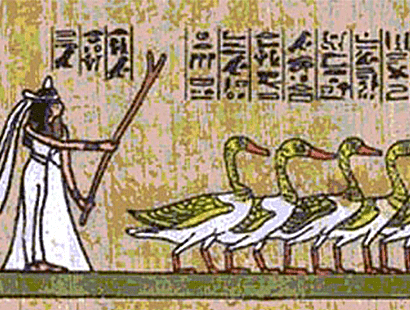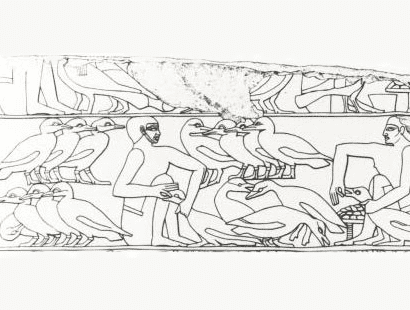Foie gras
The production of foie gras is an ancestral production that goes back more than 4500 years.
The detail of a fresco in an Egyptian tomb representing a slave feeding figs to a goose is a testimony of this thousand-year-old tradition. (Saqqara Necropolis). The banks of the Nile being a crossing point for the migration of geese and ducks, the Egyptians observed their natural ability to build up fat reserves before facing the return journey. They reproduced this natural tendency of palmipeds and thus developed progressive feeding practices (represented on several Egyptian tombs).
The technique was then perpetuated, each people using the resources available locally. It developed particularly in France from the 18th century onwards with the arrival of maize in the south-west.


How was foie gras born?
Migratory birds have the ability to store fat in order to be able to fly long distances.
In geese and ducks, this fat overload takes place in the liver. It is from the observation of this phenomenon and a selection of species, over thousands of years, that foie gras was born.
Breeding
A foie gras is the healthy liver of a healthy, robust, adult duck (or goose) raised in the traditional way: Day-olds are kept in a brooder until 4-5 weeks.
As soon as the feathers provide sufficient protection, the animals have access to outdoor runs and therefore spend about two and a half months in total freedom. At the end of the rearing period, at about 12 weeks of age, the adult birds are given a progressive and controlled diet.
Once the puppy reaches adulthood, around the third month, it is given 2 to 3 daily rations of maize exclusively for a fortnight. In this way, his liver will naturally produce the fat that will make him a fatty liver.
The animal
Producing traditional foie gras is a commitment at every moment, as each stage of production depends on precise criteria. The rural nature of the area contributes to the traditional foie gras producers' artisanal production. The breeders rely on ancestral methods, most often inherited from their long family tradition. It all starts with the selection of the birds to be force-fed.
The most commonly used ducks are Muscovy or Mulard ducks, while the most popular goose is the Landes grey goose. The latter provide a labelled foie gras. In traditional farms, the animals are free to roam in a vast space. The breeders are always concerned about the welfare of the animals and thus respect the ethical charter relating to animal welfare.
Foie gras is good for your health!
"The Périgord, Gers, Haute-Garonne and neighbouring departments, which are major consumers of duck fat, foie gras and confit, have one of the lowest coronary mortality rates (cardiovascular diseases) in France and the best life expectancy. (Renaud, de Lorgeril, 1994, in "Le Régime santé" by Serge Renaud published by Odile Jacob).
This is what American researchers and Dr Serge Renaud - a specialist in the subject - have called the French paradox.
Fatty liver is rich in unsaturated fatty acids. Their consumption is recommended in our diet because they have the effect of lowering the level of bad blood cholesterol
This quality could explain the exceptional longevity of the inhabitants of the South-West.
| Saturated fatty acids | Goose fat | Olive oil | Butter |
|---|---|---|---|
| Monounsaturated fatty acids | 27% | 65% | 52% |
| Polyunsaturated fatty acids | 57% | 13% | 23% |
| 12% | 17% | 2% |
Goose or duck, there's something for everyone
Nowadays, duck Foie Gras is the most widely consumed, with its strong taste. Goose Foie Gras, on the other hand, is finer, more delicate and is attracting more and more fans.
A raw goose Foie Gras generally weighs between 600g and 700g and a raw duck Foie Gras usually between 450g and 600g. However, in order to have the designation Foie Gras, a minimum weight must be respected: 400g for a goose Foie Gras and 300g for a duck Foie Gras.
The colour should be uniform and unblemished, the texture even and fine, and it should be firm to the touch without being hard. Goose Foie Gras is, however, slightly pinker.
Foie gras in all its forms
Raw Foie Gras is our raw material for the elaboration of our semi-cooked and canned foies gras.
Our Chef selects with the greatest rigour the raw livers for the elaboration of our products and does not use any imported foie gras. We are deeply attached to our land and respect its values.
All our products are made without colourings or preservatives.
This uncompromising requirement allows us to be rewarded each year by numerous medals (notably at the Paris Agricultural Show).
Some people buy it to cook it pan-fried. It is then presented vacuum-packed or without specific packaging, for example in the "Marché au Gras", typical of the South-West.
It can be stored for 7 days at a temperature of 0°C to + 4°C or for several months when frozen.
There are three regulated designations containing only foie gras and a seasoning:
Whole foie gras
This is a preparation consisting of one or more whole lobes of Foie Gras and a seasoning. When cut, it has a uniform colour.
The permitted seasonings are salt, sugar, spices and aromatic plants, brandies, liqueur wines and wines. Our whole foie gras is cooked with the greatest simplicity in order to exacerbate the very characteristic flavours of foie gras: only salt, sugar and pepper.


Foie gras
It is a preparation composed of the best pieces of Foie Gras lobes which can come from different geese or ducks and a seasoning.
The block of foie gras
This is a preparation composed of reconstituted Foie Gras and a seasoning with a very homogeneous presentation without apparent fat.
When pieces of Foie Gras lobes are included, it becomes a "Block of Foie Gras with pieces" and then presents a beautiful slice where the pieces are clearly visible and a great regularity of taste.
Apart from these three names, there are preparations based on goose or duck Foie Gras. The Foie Gras parfait is composed of at least 75% Foie Gras. Pâtés or mousses contain at least 50% Foie Gras. Some pâtés may contain less.
Preservation depends on the cooking method
Within the same appellation, Foies Gras are divided into two main categories according to their cooking method, which determines their texture but also their shelf life.

Semi-cooked or semi-preserved foie gras
Our semi-cooked foies gras have a beautiful marbled appearance when sliced and a very intense goose or duck flavour, which is highly sought after.
Its creamy texture is slightly firmer than that of raw Foie Gras and can be stored for 6 months at a temperature of 2°C to +4°C. In jars, cans or airtight containers, it is cooked through at a temperature below 85°C.
Canned foie gras
In jars or cans, it is cooked at a temperature above 100°C in the middle. Its taste and texture improve over the years. As the Foie Gras absorbs its own fat, it becomes smoother as it ages. It can be stored for several years (between 10 and 20°C).
